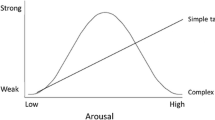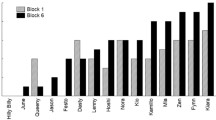Abstract
Animals may experience positive affective states in response to their own achievements. We investigated emotional responses to problem-solving in dogs, separating these from reactions to rewards per se using a yoked control design. We also questioned whether the intensity of reaction would vary with reward type. We examined the response (behavior and heart rate) of dogs as they learned to gain access to different rewards: (1) food (2) human contact, and (3) dog contact. Twelve beagles were assigned to matched pairs, and each dog served as both an experimental and a control animal during different stages of the experiment. We trained all dogs to perform distinct operant tasks and exposed them to additional devices to which they were not trained. Later, dogs were tested in a new context. When acting as an experimental dog, access to the reward was granted immediately upon completion of trained operant tasks. When acting as a control, access to the reward was independent of the dog’s actions and was instead granted after a delay equal to their matched partner’s latency to complete their task. Thus, differences between the two situations could be attributed to experimental dogs having the opportunity to learn to control access to the reward. Experimental dogs showed signs of excitement (e.g., increased tail wagging and activity) in response to their achievements, whereas controls showed signs of frustration (e.g., chewing of the operant device) in response to the unpredictability of the situation. The intensity of emotional response in experimental dogs was influenced by the reward type, i.e., greatest response to food and least to another dog. Our results suggest that dogs react emotionally to problem-solving opportunities and that tail wagging may be a useful indicator of positive affective states in dogs.









Similar content being viewed by others
References
Beerda B, Schilder BH, Van Hooff JARAM, DeVries HW, Mol JA (1999) Chronic stress in dogs subjected to social and spatial restriction. I. Behavioral responses. Physiol Behav 66:233–242
Bethus I, Tse D, Morris RG (2010) Dopamine and memory: modulation of the persistence of memory for novel hippocampal NMDA receptor-dependent paired associates. J Neurosci 30:1610–1618
Blackwell E-J, Bodnariu A, Tyson J, Bradshaw JWS, Casey RA (2010) Rapid shaping of behaviour associated with high urinary cortisol in domestic dogs. Appl Anim Behav Sci 124:113–120
Boissy A, Arnould C, Chaillou E, Désiré L, Duvaux-Ponter C, Greiveldinger L, Leterrier C, Richard S, Roussel S, Saint-Dizier H, Meunier-Salaün MC, Valance D, Veissier I (2007) Emotions and cognition: a new approach to animal welfare. Anim Welf 16:37–43
Broom DM (1988) The scientific assessment of animal welfare. Appl Anim Behav Sci 20:5–19
Broom DM (2010) Cognitive ability and awareness in domestic animals and decisions about obligations to animals. Appl Anim Behav Sci 126:1–11
Burman OHP, Parker RMA, Paul ES, Mendl M (2008) Sensitivity to reward loss as an indicator of animal emotion and welfare. Biol Lett 4:330–333
Burman O, McGowan R, Mendl M, Norling Y, Paul E, Rehn T, Keeling L (2011) Using judgement bias to measure positive affective states in dogs. Appl Anim Behav Sci 132:160–168
Buttelmann D, Tomasello M (2012) Can domestic dogs (Canis familiaris) use referential emotional expressions to locate hidden food? Anim Cogn. doi:10.1007/s10071-012-0560-4
Carere C, Locurto C (2011) Interaction between animal personality and animal cognition. Curr Zool 57:491–498
Chowdhury R, Guitart-Masip M, Bunzeck N, Dolan RJ, Düzel E (2012) Dopamine modulates episodic memory persistence in old age. J Neurosci 32:14193–14204
Cuenya L, Fosacheca S, Mustaca A, Kamenetzky G (2012) Effects of isolation in adulthood on frustration and anxiety. Behav Process 90:155–160
Fraser D, Duncan IJH (1998) ‘Pleasures’, ‘pains’ and animal welfare: toward a natural history of affect. Anim Welfare 7:383–396
Goddard ME, Beilharz RG (1985) Individual variation in agonistic behaviour in dogs. Anim Behav 33:1338–1342
Green TC, Mellor F (2011) Extending ideas about animal welfare assessment to include ‘quality of life’ and related concepts. N Z Vet J 59:263–271
Groothuis TGG, Carere C (2005) Avian personalities: characterization and epigenesis. Neuro Biobehav Rev 29:137–150
Gygax L, Reefmann N, Wolf M, Langbein J (2013) Prefrontal cortex activity, sympatho-vagal reaction and behaviour distinguish between situations of feed reward and frustration in dwarf goats. Behav Brain Res 239:104–114
Hagen K, Broom DM (2004) Emotional reactions to learning in cattle. Appl Anim Behav Sci 85:203–213
Harding EJ, Paul ES, Mendl M (2004) Animal behavior: cognitive bias and affective state. Nature 427:312
Horváth Z, Igyártó BZ, Magyar A, Miklósi Á (2007) Three different coping styles in police dogs exposed to a short-term challenge. Horm Behav 52:621–630
Hu H, Real E, Takamiya K, Kang M-G, Ledoux J, Huganir RL, Malinow R (2007) Emotion enhances learning via norepinephrine regulation of AMPA-receptor trafficking. Cell 131:160–173
Kalbe C, Puppe B (2010) Long-term cognitive enrichment affects opioid receptor expression in the amygdala of domestic pigs. Genes Brain Behav 9:75–83
Knowles PA, Conner RL, Panksepp J (1989) Opiate effects on social behavior of juvenile dogs as a function of social deprivation. Pharmocol Biochem Behav 33:533–537
Kupán K, Miklósi Á, Gergely G, Topál J (2011) Why do dogs (Canis familiaris) select the empty container in an observational learning task? Anim Cogn 14:259–268
Langbein J, Nürnberg G, Manteuffel G (2004) Visual discrimination learning in dwarf goats and associated changes in heart rate and heart rate variability. Physiol Behav 82:601–609
Langbein J, Siebert K, Nürnberg G (2009) On the use of an automated learning device by group-housed dwarf goats: do goats seek cognitive challenges? Appl Anim Behav Sci 120:150–158
Lit L, Schweitzer JB, Oberbauer AM (2011) Handler beliefs affect scent detection dog outcomes. Anim Cogn 14:387–394
McGowan RTS, Robbins CT, Alldredge JR, Newberry RC (2010) Contrafreeloading in grizzly bears: implications for captive foraging enrichment. Zoo Biol 29:484–502
McLeod PJ (1996) Developmental changes in associations among timber wolf (Canis lupos) postures. Behav Process 38:105–118
Meehan CL, Mench JA (2007) The challenge of challenge: can problem solving opportunities enhance animal welfare? Appl Anim Behav Sci 102:246–261
Mendl M, Burman OHP, Paul ES (2010) An integrative and functional framework for the study of animal emotion and mood. Proc R Soc B 277:2895–2904
Norling Y, Wiss V, Gorjanc G, Keeling LJ (2012) Body language of dogs responding to different types of stimuli. In: Proceedings of the 46th congress of the international society for applied ethology, July 31st–August 4th, Vienna, p 199
Panksepp J (1998) Affective neuroscience: the foundations of human and animal emotions. Oxford University Press, New York
Panksepp J (2011) The basic emotional circuits of mammalian brains: do animals have affective lives? Neurosci Biobehav Rev 35:1791–1804
Panksepp J, Conner R, Forster PK, Bishop P, Scott JP (1983) Opiod effects on social behavior of kennel dogs. J Appl Ethol 10:63–74
Paul ES, Harding EJ, Mendl M (2005) Measuring emotional processes in animals: the utility of a cognitive approach. Neurosci Biobehav Rev 29:469–491
Prescott MJ, Morton DB, Anderson D, Buckwell A, Heath S, Hubrecht R, Jennings M, Robb D, Ruane B, Swallow J, Thompson P (2004) Refining dog husbandry and care. BVAAWF/FRAME/RSPCA/UFAW joint working group on refinement. Lab Anim 38(S1):11–24
Quaranta A, Siniscalchi M, Vallortigara G (2007) Asymmetric tail-wagging response by dogs to different emotive stimuli. Curr Biol 17:199–201
Rehn T, Keeling LJ (2010) Investigating greeting behaviour in dogs reunited with a familiar person. In: Proceedings of the 44th congress of the international society for applied ethology, August 4–7, Uppsala, p 54
Rooney NJ, Bradshaw JWS, Robinson IH (2000) A comparison of dog–dog and dog-human play behaviour. Appl Anim Behav Sci 66:235–248
Sakaki M, Niki K, Mather M (2012) Beyond arousal and valence: the importance of the biological versus social relevance of emotional stimuli. Cogn Affect Behav Neurosci 12:115–139
Spruijt BM, Van den Bos R, Pijlman FTA (2001) A concept of welfare based on reward evaluating mechanisms in the brain: anticipatory behaviour as an indicator for the state of reward systems. Appl Anim Behav Sci 72:145–171
Svartberg K, Forkman B (2002) Personality traits in the domestic dog (Canis familiaris). Appl Anim Behav Sci 79:133–155
Wemelsfelder F (2007) How animals communicate quality of life: the qualitative assessment of behaviour. Anim Welf 16(S):25–31
Zebunke M, Langbein J, Manteuffel G, Puppe B (2011) Autonomic reactions indicating positive affect during acoustic reward learning in domestic pigs. Anim Behav 81:481–489
Acknowledgments
This project was funded by the Swedish Research Council for Environment, Agricultural Sciences and Spatial Planning (FORMAS). The final stages of this work were carried out in collaboration within the Centre of Excellence in Animal Welfare Science, a Swedish collaborative research environment.
Conflict of interest
None.
Ethical standards
This study was reviewed and approved by the Swedish Ethical Committee on Animal Research in Uppsala, Sweden. All aspects of the study comply with the current laws of Sweden where the study was performed.
Author information
Authors and Affiliations
Corresponding author
Rights and permissions
About this article
Cite this article
McGowan, R.T.S., Rehn, T., Norling, Y. et al. Positive affect and learning: exploring the “Eureka Effect” in dogs. Anim Cogn 17, 577–587 (2014). https://doi.org/10.1007/s10071-013-0688-x
Received:
Revised:
Accepted:
Published:
Issue Date:
DOI: https://doi.org/10.1007/s10071-013-0688-x




